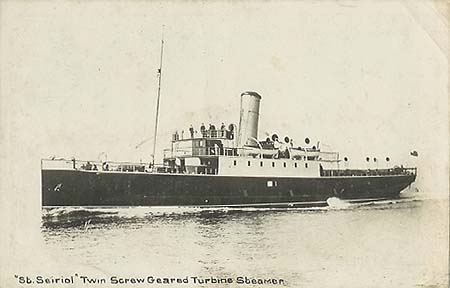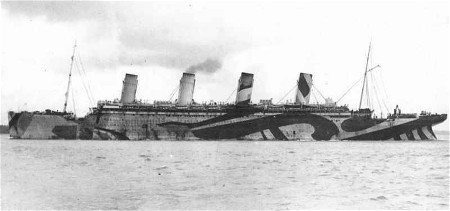|
Sep 11, 1879
|
Born in Mattawa,
Ontario to Joseph and Annie (nee O’Brien) Desermeau
|
|
Feb 11, 1915
|
Attested into the
21st Battalion in Kingston, Ontario
Ø
Number 59257
(temporary number 1235)
Ø
Next of kin given
as Joseph Desermeau, father, Mattawa, Ontario
Ø
Previous
occupation given as Lumberman
o
Later noted as
Construction Foreman
Ø
No previous
military experience given
Ø
Posted to the
battalion’s Base Unit
Frank’s
brother, Albert Desermeau
attested into the same day
The
21st Battalion trained in the Kingston, Ontario
area through the winter of 1914-15.
|
|
May 6, 1915
|
Embarked the RMS
Metagama in Montreal, Quebec

|
|
May 15, 1915
|
Disembarked in
Devonport, England and the battalion proceeded to the West Sandling
Camp, near Hythe, Kent to continue training
|
|
Sep 14, 1915
|
Embarked the St.
Seiriol in Folkestone

|
|
Sep 15, 1915
|
Disembarked in
Boulogne, France and the battalion proceeded to St. Omer
|
|
Apr 22, 1916
|
While in the
vicinity of Voormezeele, Belgium, the 21st
Battalion came under attack by an artillery barrage and Private
Desermeau received a shrapnel wound to his left forearm. He was evacuated to the
No. 6 Canadian Field Ambulance for first aid before being transported
to the No. 10 Casualty Clearing Station for treatment.
Because of the severity of the wound, he was
quickly loaded onto the No. 15 Ambulance Train for transportation to be
admitted to the No. 3 Canadian General Hospital in Boulogne, France
|
|
May 6, 1916
|
Transferred to the
No. 1 Convalescent Depot to continue his recovery
|
|
May 16, 1916
|
Discharged to
light duties with the base details in Boulogne
|
|
May 21, 1916
|
Transferred to the
Canadian Base Depot in the Rouelles Camp, Havre
|
|
Jun 8, 1916
|
After leaving the
base depot, Frank Desermeau rejoined the 21st
Battalion in billets in Dickebusch, Belgium
|
|
Jul 4, 1916
|
Private Frank
Desermeau was buried by the explosion of a nearby artillery shell and
was suffering from a concussion when he was dug out.
He was evacuated to the No. 6 Canadian Field
Ambulance for first aid then transported to the No. 4 Canadian Field
Ambulance.
|
|
Jul 8, 1916
|
Transferred to the
2nd Divisional Rest Station to recover from his
concussion
|
|
Jul 14, 1916
|
Transferred to the
NMCCS (North Midlands Casualty Clearing Station) at Mont des Cats with
a diagnosis that reads Myalgia
|
|
Jul 23, 1916
|
Discharged from
the casualty clearing station and rejoined the 21st
Battalion in the front line trenches near Verbrande Molen, Belgium
|
|
Jan 21, 1917
|
Granted 10 days
leave
|
|
Feb 7, 1917
|
Rejoined the
battalion from leave
|
|
Feb 11, 1917
|
Awarded the Good
Conduct Badge
|
|
Apr 29, 1917
|
Appointed to the
rank of Acting Corporal without pay
|
|
Sep 12, 1917
|
Granted 10 days
leave
|
|
Sep 24, 1917
|
Rejoined the
battalion from leave
|
|
Sep 25, 1917
|
Reverted to the
rank of Private
|
|
Mar 5, 1918
|
Reported to be
absent from 5:00 pm to 8:30 pm. It
is noteworthy that the battalion was occupying the front line trenches
west of Lens, France at the time
|
|
Mar 8, 1918
|
Sentenced to 14
days Field Punishment No. 1 and forfeited his Good Conduct Badge for
his absence
|
|
May 1, 1918
|
Admitted to the
No. 6 Canadian Field Ambulance with a diagnosis that reads Debility. He was transferred the
same day, first to the No. 5 Canadian Field Ambulance then to the
nearby casualty clearing station
|
|
May 4, 1918
|
Transferred to the
No. 6 Stationary Hospital
|
|
May 7, 1918
|
Transferred via an
ambulance train and admitted to the No. 10 General Hospital in Rouen,
France
|
|
May 18, 1918
|
Transferred to the
No. 2 Convalescent Depot
|
|
May 21, 1918
|
Discharged to the
Base Details
|
|
May 24, 1918
|
Proceeded to the
No. 2 CIBD (Canadian Infantry Base Depot) in Etaples
|
|
Jul 3, 1918
|
His medical
classification was changed to read B1, meaning that he was not fit for
combat duty and he was then transferred to the Canadian Labour Pool
|
|
Jul 16, 1918
|
After leaving the
base depot, he joined the Canadian Corps Reinforcement Camp in Aubin
St. Vaast and was transferred to the CASC (Canadian Army Service Corps)
Pool
|
|
Nov 2, 1918
|
Transferred to the
2nd Canadian Division Train
|
|
Dec 13, 1918
|
Transferred to the
CASCD (Canadian Army Service Corps Depot) in the Bordon Camp, England
|
|
Dec 27, 1918
|
Attached to
Military District No. 2 “C” Wing, Kinmel Park,
Rhyl, pending return to Canada
|
|
Jan 11, 1919
|
Embarked the SS
Olympic in Southampton

|
|
Jan 17, 1919
|
Disembarked in
Halifax, Nova Scotia and proceeded to Toronto, Ontario
Taken
On Strength Military District No. 2 Depot, Toronto, Ontario and posted
to the Casualty Company
|
|
Jan 21, 1919
|
Granted leave
until February 7, 1919
|
|
Feb 8, 1919
|
Medical Report at
the Exhibition Camp notes
Ø
Patient complains
of restlessness and poor sleeping
Ø
Lacks confidence
in himself
Ø
Suffers from poor
memory
Ø
Knee jerks very
active
Ø
Suffers from
Hallux Valgus in both feet causing pain when he walks
Ø
Admits to chronic
alcoholism to the extent of mild hallucinations
Ø
Would occasionally
drink until all his money is gone
Ø
Suffers from mild
Neurasthenia, 10% due to service
Ø
Should improve in
6 months
|
|
Feb 14, 1919
|
Discharged from
the CEF in Toronto, Ontario
Ø
Rank on discharge
Private
Ø
War Service Badge
Class “A” issued
Ø
Proposed residence
on discharge Mattawa, Ontario
Following
his discharge, the 1914-15 Star, British War Medal and Victory Medals
were sent to him at Box 163 Timiskaming, Quebec
|
|